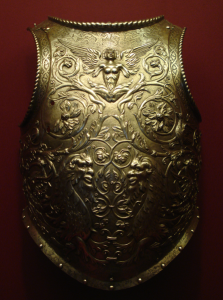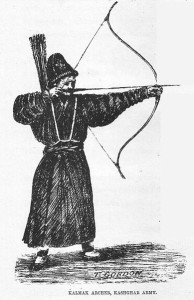 The weapons system in Dungeon World is perhaps the best (for my purposes) that I have seen in any published RPG. It uses a tag-based system to distribute effects between the various weapons. Thus, they become distinctive while offering interesting trade-offs. Best of all, it looks like it could be dropped, unmodified, over a flat d6 or class-based damage system in D&D. Dungeon World itself assumes class-based damage.
The weapons system in Dungeon World is perhaps the best (for my purposes) that I have seen in any published RPG. It uses a tag-based system to distribute effects between the various weapons. Thus, they become distinctive while offering interesting trade-offs. Best of all, it looks like it could be dropped, unmodified, over a flat d6 or class-based damage system in D&D. Dungeon World itself assumes class-based damage.
It’s not perfect, as there are some items that are just plainly suboptimal other than cost (such as elven arrows versus normal arrows), and I’m never satisfied with cost being the main differentiator because it is not really much of an obstacle in a game about treasure hunters (DW is by assumption less coin-heavy than traditional D&D though, so maybe it works there).
For other weapon systems that try to approach the problem similarly, see:
- Weapons & Parrying Draft
- Jack’s Toolbox: On Meaningful Weapons (has some 3E assumptions)
General Equipment Tags
These are general tags that can apply to just about any piece of gear. You’ll see them on armor, weapons or general adventuring tools. Applied: It’s only useful when carefully applied to a person or to something they eat or drink.
- Awkward: It’s unwieldy and tough to use.
- +Bonus: It modifies your effectiveness in a specified situation. It might be “+1 forward to spout lore” or “-1 ongoing to hack and slash.”
- n coins: How much it costs to buy, normally. If the cost includes “-Charisma” a little negotiation subtracts the haggler’s Charisma score (not modifier) from the price.
- Dangerous: It’s easy to get in trouble with it. If you interact with it without proper precautions the GM may freely invoke the consequences of your foolish actions.
- Ration: It’s edible, more or less.
- Requires: It’s only useful to certain people. If you don’t meet the requirements it works poorly, if at all.
- Slow: It takes minutes or more to use.
- Touch: It’s used by touching it to the target’s skin.
- Two-handed: It takes two hands to use it effectively.
- n weight: Count the listed amount against your Load. Something with no listed weight isn’t designed to be carried. 100 coins in standard denominations is 1 weight. The same value in gems or fine art may be lighter or heavier.
- Worn: To use it, you have to be wearing it.
- n Uses: It can only be used n times.
Weapons
Weapons don’t kill monsters, people do. That’s why weapons in Dungeon World don’t have a listed damage. A weapon is useful primarily for its tags which describe what the weapon is useful for. A dagger is not useful because it does more or less damage than some other blade. It’s useful because it’s small and easy to strike with at close distance. A dagger in the hands of the wizard is not nearly so dangerous as one in the hands of a skilled fighter.
Weapon Tags
Weapons may have tags that are primarily there to help you describe them (like Rusty or Glowing) but these tags have a specific, mechanical effect.
- n Ammo: It counts as ammunition for appropriate ranged weapons. The number indicated does not represent individual arrows or sling stones, but represents what you have left on hand.
- Forceful: It can knock someone back a pace, maybe even off their feet.
- +n Damage: It is particularly harmful to your enemies. When you deal damage, you add n to it.
- Ignores Armor: Don’t subtract armor from the damage taken.
- Messy: It does damage in a particularly destructive way, ripping people and things apart.
- n Piercing: It goes right through armor. When you deal damage with n piercing, you subtract n from the enemy’s armor for that attack.
- Precise: It rewards careful strikes. You use DEX to hack and slash with this weapon, not STR.
- Reload: After you attack with it, it takes more than a moment to reset for another attack.
- Stun: When you attack with it, it does stun damage instead of normal damage.
- Thrown: Throw it at someone to hurt them. If you volley with this weapon, you can’t choose to mark off ammo on a 7–9; once you throw it, it’s gone until you can recover it.
Weapons have tags to indicate the range at which they are useful. Dungeon World doesn’t inflict penalties or grant bonuses for “optimal range” or the like, but if your weapon says Hand and an enemy is ten yards away, a player would have a hard time justifying using that weapon against him.
- Hand: It’s useful for attacking something within your reach, no further.
- Close: It’s useful for attacking something at arm’s reach plus a foot or two.
- Reach: It’s useful for attacking something that’s several feet away— maybe as far as ten.
- Near: It’s useful for attacking if you can see the whites of their eyes.
- Far: It’s useful for attacking something in shouting distance.
Weapon List
The stats below are for typical items. There are, of course, variations. A dull long sword might be -1 damage instead while a masterwork dagger could be +1 damage. Consider the following to be stats for typical weapons of their type—a specific weapon could have different tags to represent its features.
| Ragged Bow |
near, 15 coins, 2 weight
|
| Fine Bow |
near, far, 60 coins, 2 weight
|
| Hunter’s Bow |
near, far, 100 coins, 1 weight
|
| Crossbow |
near, +1 damage, reload, 35 coins, 3 weight
|
| Bundle of Arrows |
3 ammo, 1 coin, 1 weight
|
| Elven Arrows |
4 ammo, 20 coins, 1 weight
|
| Club, Shillelagh |
close, 1 coin, 2 weight
|
| Staff |
close, two-handed, 1 coin, 1 weight
|
| Dagger, Shiv, Knife |
hand, 2 coins, 1 weight
|
| Throwing Dagger |
thrown, near, 1 coin, 0 weight
|
| Short Sword, Axe, Warhammer, Mace |
close, 8 coins, 1 weight
|
| Spear |
reach, thrown, near, 5 coins, 1 weight
|
| Long Sword, Battle Axe, Flail |
close, +1 damage, 15 coins, 2 weight
|
| Halberd |
reach, +1 damage, two-handed, 9 coins, 2 weight
|
| Rapier |
close, precise, 25 coins, 1 weight
|
| Dueling Rapier |
close, 1 piercing, precise, 50 coins, 2 weight
|








